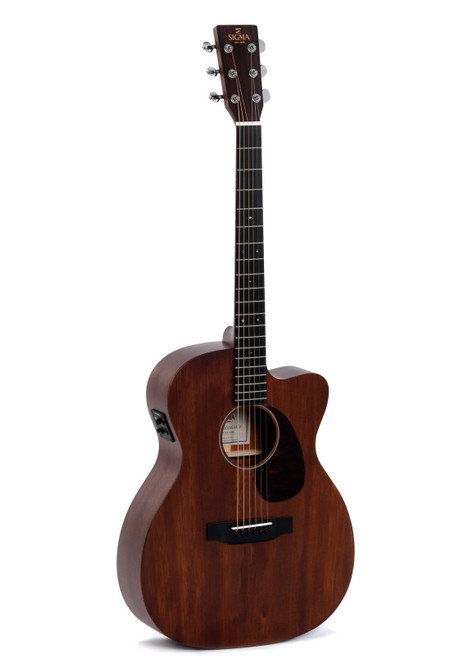Product Overview
Body Size: 000-14 Fret, Cutaway
Top: Soild Sitka Spruce
Back & Sides: Mahogany
Neck: Mahogany
Nut: Bone
Saddle: Bone/Compensated
Fingerboard: Micarta
Scale Length: 25.4"
Neck width at nut: 1 11/16" (42.9mm)
Tuning Machines: Chrome die-cast
Electronics: Fishman Presys II (with tuner)
In the late 1960s the situation for US guitar manufacturers became difficult: guitars that were made in Japan, looking very similar to US guitars, were flooding the market but at a much lower price. These guitars increasingly endangered the US manufacturers dominance on the market, and a few American companies reacted to that development in an appropriate manner: They did not take any legal steps but instead launched a counter offensive. That’s when “Sigma Guitars” was born.
In 1970 “SIGMA”, the brandname for acoustic guitars, was launched. They were built by specially trained staff in the most efficient guitar factories in Japan and then sent to the US for inspection before being released for sale and shipping to the music stores.
The first Japanese made Sigma guitars were quite different to the instruments built in the following years in other countries. After several years of production the manufacturing of the guitars was moved to Korea, with new model numbers in place, and the development of a new logo.
From then on every single guitar featured on the headstock the following words with pride: “Sigma Guitars Est. 1970”.
“Sigma Guitars” were soon to have an excellent, even legendary, reputation. Some models were said to be of outstanding quality, both, in construction and sound. That’s why it is striking, but not surprising, that there are hardly any second-hand Sigma guitars up for sale. Most owners still swear by their instruments and would never part with them. There are Sigma fans, Sigma communities, Sigma websites; and even collectors have specialised in Sigma guitars.
AMI in Germany have taken over the Sigma legacy and are committed and obliged to this tradition. As a distributor of fine acoustic and classical guitars for over 25 years, it is a great honour for AMI to obtain for some parts of the world the rights of the time-honoured name “Sigma Guitars Est. 1970” as well as the distinct Sigma logo.
AMI's business partner and guitar manufacturer in Asia is one of the most respected makers who has been building outstanding quality guitars for over 20 years.
This is where the circle closes:
“Sigma Guitars Est. 1970”, has returned, and bmusic are proud to be part of this legend.
Top: Soild Sitka Spruce
Back & Sides: Mahogany
Neck: Mahogany
Nut: Bone
Saddle: Bone/Compensated
Fingerboard: Micarta
Scale Length: 25.4"
Neck width at nut: 1 11/16" (42.9mm)
Tuning Machines: Chrome die-cast
Electronics: Fishman Presys II (with tuner)
In the late 1960s the situation for US guitar manufacturers became difficult: guitars that were made in Japan, looking very similar to US guitars, were flooding the market but at a much lower price. These guitars increasingly endangered the US manufacturers dominance on the market, and a few American companies reacted to that development in an appropriate manner: They did not take any legal steps but instead launched a counter offensive. That’s when “Sigma Guitars” was born.
In 1970 “SIGMA”, the brandname for acoustic guitars, was launched. They were built by specially trained staff in the most efficient guitar factories in Japan and then sent to the US for inspection before being released for sale and shipping to the music stores.
The first Japanese made Sigma guitars were quite different to the instruments built in the following years in other countries. After several years of production the manufacturing of the guitars was moved to Korea, with new model numbers in place, and the development of a new logo.
From then on every single guitar featured on the headstock the following words with pride: “Sigma Guitars Est. 1970”.
“Sigma Guitars” were soon to have an excellent, even legendary, reputation. Some models were said to be of outstanding quality, both, in construction and sound. That’s why it is striking, but not surprising, that there are hardly any second-hand Sigma guitars up for sale. Most owners still swear by their instruments and would never part with them. There are Sigma fans, Sigma communities, Sigma websites; and even collectors have specialised in Sigma guitars.
AMI in Germany have taken over the Sigma legacy and are committed and obliged to this tradition. As a distributor of fine acoustic and classical guitars for over 25 years, it is a great honour for AMI to obtain for some parts of the world the rights of the time-honoured name “Sigma Guitars Est. 1970” as well as the distinct Sigma logo.
AMI's business partner and guitar manufacturer in Asia is one of the most respected makers who has been building outstanding quality guitars for over 20 years.
This is where the circle closes:
“Sigma Guitars Est. 1970”, has returned, and bmusic are proud to be part of this legend.












